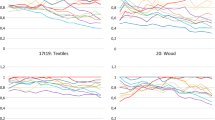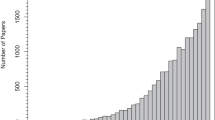Abstract
This paper examines the impact of R&D on multifactor productivity in the U.S. agricultural sector over the 1910–1990 period. We use the Bennet–Bowley indicator to measure agricultural productivity based on a multiple output-multiple input technology. We demonstrate the relationship between the price dependent Bennet–Bowley indicator and the Luenberger productivity indicator which is constructed from directional distance functions without requiring price information. These performance measures are dual to the profit function which arguably makes them especially useful in the agricultural setting. We employ time-series techniques to investigate the effect of R&D on the pattern of productivity growth. We find that we cannot reject the presence of a cointegrating relationship between the two series and that productivity growth in the U.S. agriculture responds positively to R&D expenditure with a lag of between four and ten periods.




Similar content being viewed by others
Notes
Färe et al. (2007) provide a condition for \(\pounds^t\) to equal \(\pounds^{t+1}.\) It states that the distance function must be additively separable in inputs/outputs and time.
See Balk (2003), who attributed this index to Törnqvist.
This was first shown by Balk et al. (2008).
The quadratic form readily allows for the translation property of the directional distance function, see Chambers (2002).
References
Balk BM (1998) Industrial price, quantity and productivity indices: the microeconomic theory and application. Kluwer, Boston
Balk BM, Färe R, Grosskopf S, Margaritis D (2008) The equivalence between the Luenberger productivity indicator and the Malmquist productivity index. Econ Theor 35:187–190
Bennet TL (1920) The theory of measurement of changes in cost of living. J R Stat Soc 83:455–462
Chambers RG (1996) A new look at exact input, output, productivity and technical change measurement. Mimeo, Department of Agricultural and Resource Economics, University of Maryland, College Park
Chambers RG (2002) Exact nonradial input, output, and productivity measurement. Econ Theor 20:751–767
Chambers RG, Färe R, Grosskopf S (1996) Productivity growth in APEC countries. Pacific Econ Rev 1:181–190
Chambers RG, Chung Y, Färe R (1998) Profit, directional distance functions and Nerlovian efficiency. J Optim Theory Appl 95(2):351–364
Diewert WE (1976) Exact and superlative index numbers. J Econometrics 4:115–145
Färe R, Grosskopf S, Margaritis D (2007) Productivity and efficiency: Malmquist and More. In: Fried HO, Lovell CAK, Schmidt SS (eds) The measurement of productive efficiency and productivity growth. Oxford University Press, New York
Lau LJ (1979) On exact index numbers. Rev Econ Stat 61:73–82
Luenberger DG (1992) New optimality principles for economic efficiency and equilibrium. J Optim Theory Appl 75:221–264
Shephard RW (1970) Theory of cost and production functions. Princeton University Press, Princeton, NJ
Thirtle CG, Schimmelpfennig DE, Townsend RE (2002) Induced innovation in U.S. agriculture, 1880–1990: time-series tests and an error correction model. Am J Agric Econ 84(3):598–614
Author information
Authors and Affiliations
Corresponding author
Additional information
We would like to thank Steve Buccola, Ken Carlaw and the participants in the 2005 NZESG meetings at the University of Canterbury and the EWEPA conference in Brussels for their comments.
Rights and permissions
About this article
Cite this article
Färe, R., Grosskopf, S. & Margaritis, D. U.S. productivity in agriculture and R&D. J Prod Anal 30, 7–12 (2008). https://doi.org/10.1007/s11123-008-0092-8
Published:
Issue Date:
DOI: https://doi.org/10.1007/s11123-008-0092-8




